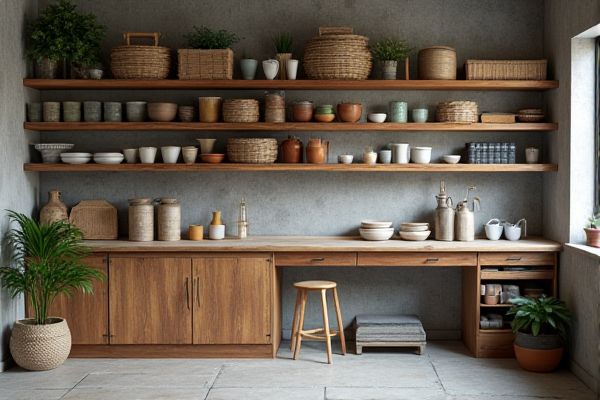
Utility shelves prioritize functionality and durability, ideal for storing tools, cleaning supplies, and heavy items, while display shelves focus on aesthetics and showcasing decorative objects or merchandise. Discover how choosing the right type of shelf can enhance both your storage efficiency and room design by reading the rest of the article.
Table of Comparison
| Feature | Utility Shelves | Display Shelves |
|---|---|---|
| Purpose | Storage and organization of tools, equipment, and everyday items | Showcasing decorative items, collectibles, and merchandise |
| Material | Durable materials like metal, reinforced wood, and plastic | Elegant materials such as glass, polished wood, or acrylic |
| Design | Functional, sturdy, and space-efficient | Stylish, aesthetic, often with emphasis on visibility |
| Weight Capacity | High weight capacity for heavy and bulky items | Lower weight capacity, designed for lightweight items |
| Location | Garages, workshops, utility rooms | Living rooms, retail stores, galleries |
| Price Range | Generally affordable and practical | Varies; often more expensive due to design and materials |
| Visual Appeal | Minimal focus on aesthetics | High emphasis on appearance and style |
Introduction to Utility Shelves and Display Shelves
Utility shelves are designed primarily for practical storage, supporting heavy items in garages, workshops, or storage rooms with durable materials like metal or reinforced plastic. Display shelves prioritize aesthetics, featuring lightweight, decorative designs crafted from wood, glass, or metal to showcase items in living rooms, retail stores, or galleries. Choosing between utility and display shelves depends on the balance of functionality and visual appeal required for the specific space.
Key Differences Between Utility and Display Shelves
Utility shelves prioritize functionality and durability, designed to hold heavy items and withstand frequent use, often found in garages, workshops, and storage rooms. Display shelves emphasize aesthetics and visibility, crafted to showcase decorative items, collectibles, or retail products with an attractive design and open structure. Key differences include load capacity, material choice, and placement, with utility shelves favoring robust metals or heavy-duty plastics and display shelves utilizing glass, wood, or stylish metal finishes to enhance visual appeal.
Materials Used in Utility vs Display Shelving
Utility shelves are commonly constructed from durable materials such as steel, wire, or heavy-duty plastic to support heavy loads and withstand rough usage. Display shelves often feature wood, glass, or acrylic, emphasizing aesthetics while providing sufficient strength for showcasing items. Your choice depends on whether functionality or visual appeal is the priority for your shelving needs.
Design and Aesthetic Considerations
Utility shelves prioritize functionality with sturdy materials and simple designs suited for storage and organization, while display shelves emphasize aesthetics, featuring elegant finishes and decorative elements to showcase items attractively. Your choice depends on whether practicality or visual appeal is the primary goal in your space. Display shelves often incorporate glass, metal accents, and unique shapes, enhancing room decor, whereas utility shelves focus on maximizing capacity and durability.
Functionality and Practical Applications
Utility shelves emphasize robust construction and maximize storage capacity, making them ideal for organizing tools, supplies, and heavy items in garages or warehouses. Display shelves prioritize aesthetic appeal and accessibility, perfect for showcasing merchandise, decor, or collectibles in retail spaces and living areas. Both types optimize space, but utility shelves focus on durability while display shelves enhance visual presentation.
Organization and Storage Efficiency
Utility shelves maximize organization and storage efficiency by accommodating heavy-duty items and offering adjustable configurations, ideal for garages or workshops. Display shelves prioritize visual appeal and easy access, designed to showcase products or decor while maintaining tidy arrangements in retail or living spaces. Both types optimize space but differ in load capacity and aesthetic focus, influencing their suitability for specific organizational needs.
Durability and Maintenance Requirements
Utility shelves are designed with heavy-duty materials like steel or reinforced wood, offering high durability for storing tools, equipment, or bulk items under frequent use. They require minimal maintenance, often only periodic cleaning and inspection for rust or damage, making them ideal for industrial or garage settings. Display shelves prioritize aesthetic materials such as glass or polished wood, necessitating more careful upkeep like regular dusting and gentle cleaning to maintain their visual appeal and prevent scratches.
Cost Comparison: Utility Shelves vs Display Shelves
Utility shelves typically cost less than display shelves due to their simpler design and use of basic materials like metal or plastic. Display shelves often feature higher-end finishes, decorative elements, and specialized lighting, which increase their price. If your priority is budget-friendly storage, utility shelves provide a cost-effective solution without sacrificing functionality.
Best Uses for Utility Shelves
Utility shelves excel in organizing tools, cleaning supplies, and heavy-duty equipment in garages or workshops due to their sturdy construction and adjustable designs. Unlike display shelves, which prioritize aesthetics for showcasing decorative items, utility shelves focus on maximizing storage efficiency and durability for practical items. Your best choice depends on whether you need robust, functional storage or visually appealing arrangement.
Best Uses for Display Shelves
Display shelves are best suited for showcasing decorative items, collectibles, and merchandise in retail environments to attract customer attention. Their design emphasizes aesthetics, often featuring glass or open fronts that highlight the visual appeal of displayed objects. Ideal placement includes living rooms, stores, and galleries where presentation and accessibility are key priorities.
 homyna.com
homyna.com